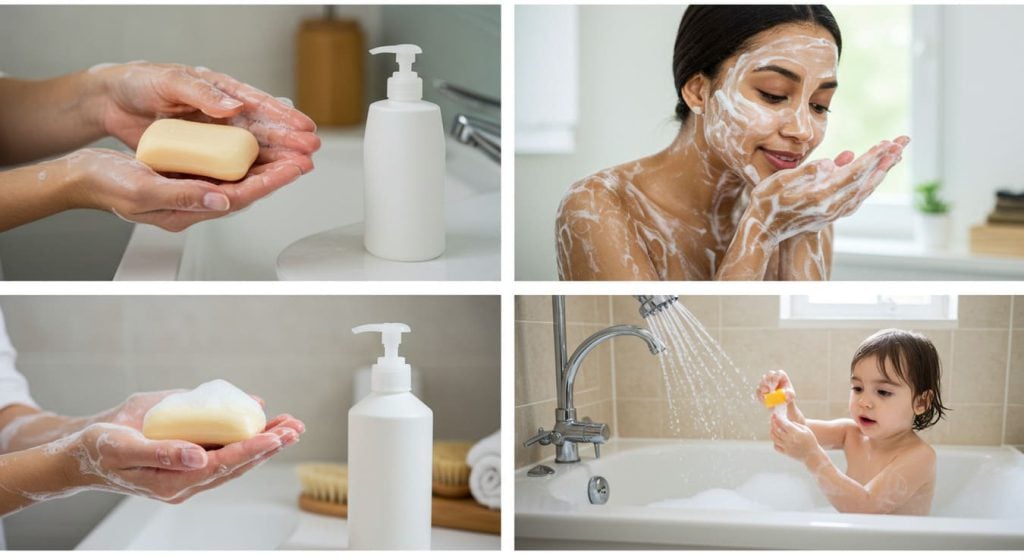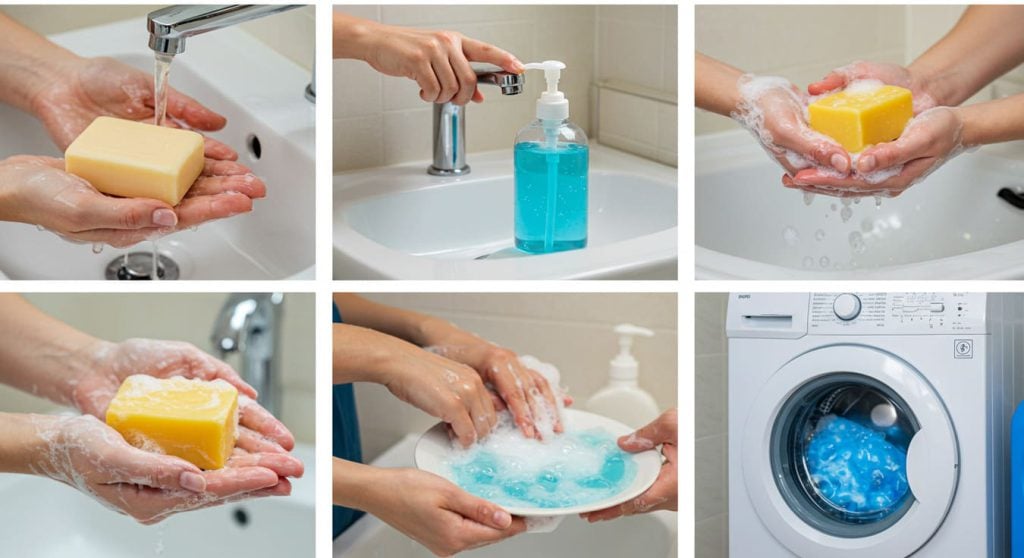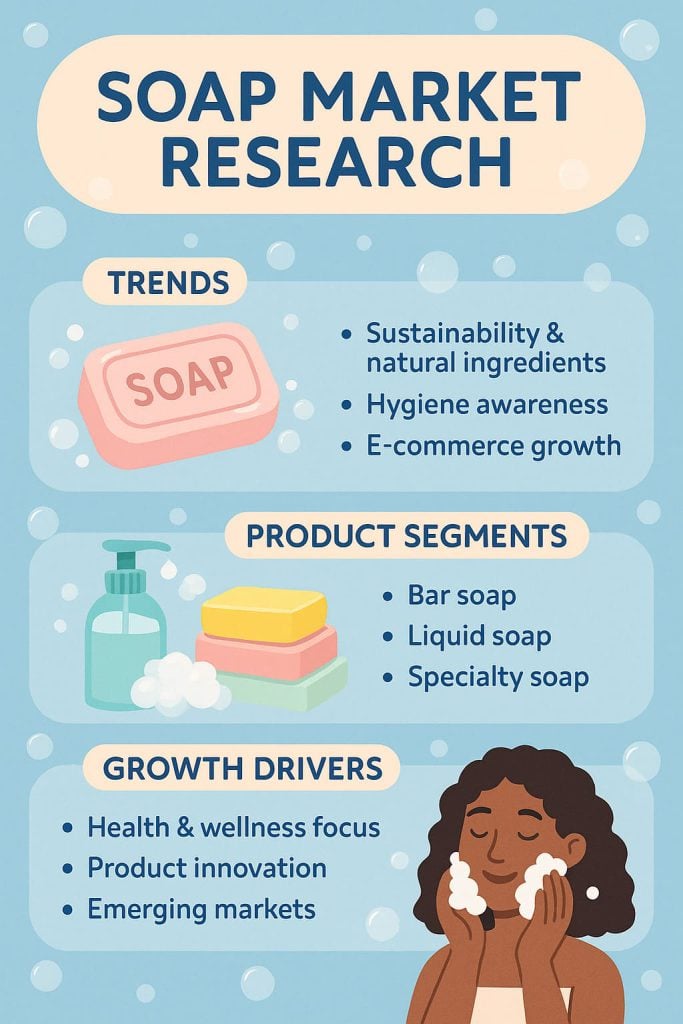Soap Market Research

Soap market research encompasses a comprehensive soap industry analysis, covering various aspects such as market trends, consumer preferences, competitive landscape, and growth opportunities.
What drives consumers to select one soap brand over another in a market with options? Soap market research dives into the intricacies of consumer preferences, fragrances, branding, and ethical considerations that influence purchasing decisions. In an industry where the lines between hygiene, luxury, and sustainability often intersect, gaining insights from this research becomes vital for brands aiming to lather up success in a competitive landscape
Table of Contents
✅ Listen to this PODCAST EPISODE here:
What Is Soap Market Research?
Soap market research studies consumer behavior, market trends, competitor analysis, and product performance. It helps businesses understand consumer preferences and market trends to develop effective marketing strategies and create products that meet the needs of their target audience. This research also analyzes the overall market dynamics, such as market size, growth potential, and key players. This information helps businesses identify market gaps, spot emerging trends, and make data-driven decisions.
Why Is Soap Market Research So Important?
Soap market research is essential for several reasons. First, it allows businesses to better understand their target audience. By gaining insights into consumer preferences, needs, and pain points, companies can tailor their products and marketing strategies to meet customer demands better. By analyzing competitors’ strategies and offerings, companies can identify areas for improvement and differentiate themselves in the market. This allows them to stay ahead of the competition and retain a loyal customer base.
In any case, it brings several benefits for businesses, including:
- Identify consumer preferences: Market research helps businesses understand factors influencing purchasing decisions, such as fragrance, ingredients, packaging, and price. This knowledge allows companies to create products that align with consumer preferences, increasing customer satisfaction and loyalty.
- Spot market trends: Businesses can analyze market data to identify emerging trends in the soap industry. These include new ingredients, packaging innovations, sustainability initiatives, and more. Staying ahead of trends allows companies to meet consumer demands and gain a competitive edge.
- Optimize marketing strategies: This market research provides insights into the most effective marketing channels, messaging, and promotions. By understanding consumer behavior and preferences, businesses can tailor their marketing efforts to reach their target audience more effectively and generate higher sales.
- Improve product development: By gathering consumer feedback through surveys or focus groups, businesses can gain valuable insights into product performance, quality, and usability. This feedback can be used to refine existing products or develop new ones that better meet consumer needs.
- Minimize business risks: Making informed decisions based on market research helps businesses minimize risks associated with product launches, market expansions, and other strategic initiatives. By understanding market dynamics and consumer preferences, companies can make data-driven decisions that are more likely to succeed.
Who Uses Soap Market Research?

Soap Manufacturers rely on market research to understand consumer preferences, trends, and competitive dynamics shaping the industry. By leveraging market insights, manufacturers can optimize their product development, manufacturing processes, and marketing strategies to meet consumer demands effectively and gain a competitive edge in the marketplace.
Market research helps Retailers and Distributors identify market trends, consumer preferences, and emerging opportunities to optimize their product assortment, pricing strategies, and promotional activities. By aligning their business strategies with market demands, enhancing customer satisfaction, and driving sales performance in their stores and channels, retailers and distributors can achieve success.
Investors and Financial Analysts rely on soap market research to assess soap companies and brands’ investment potential and financial performance. By analyzing market trends, competitive dynamics, and growth prospects, investors can make informed investment decisions, allocate capital effectively, and optimize portfolio performance in the soap industry.
Regulatory Bodies and Policy Makers use soap market research to monitor industry trends, consumer preferences, and regulatory compliance within the soap industry. With market research, regulatory bodies can assess soap products’ safety, efficacy, and environmental impact, enforce quality standards, and develop policies and regulations that safeguard consumer health and environmental sustainability.
When to Conduct Soap Market Research
Determining the right timing for conducting soap market research is crucial for maximizing its effectiveness and relevance. Here are some key considerations:
- New Product Development: Soap market research should be conducted during the initial stages of new product development to gather insights into consumer preferences, market trends, and the competitive landscape.
- Market Expansion: When planning to enter new geographic markets or target new customer segments, businesses should research the soap market to assess market opportunities, competitive dynamics, and regulatory requirements.
- Shifting Consumer Trends and Preferences: Consumer preferences and market trends evolve, making it essential for businesses to regularly conduct soap market research to stay abreast of changing consumer needs and market dynamics.
Table 1. Global Soap Market Research Data
Global Soap Market Research Data
| Metric | Value | Growth/Change | Source |
|---|---|---|---|
| Global Market Size & Projections | |||
| Global Soap Market Size (Current) | $50.68 Billion USD | 6.05% CAGR to 2032 | Fortune Business Insights |
| Projected Market Size (2032) | $76.45 Billion USD | Strong growth trajectory | Fortune Business Insights |
| Bath Soap Market Size (Current) | $24.6 Billion USD | 3.57% CAGR to 2033 | IMARC Group |
| Bar Soap Market Size (Current) | $30.16 Billion USD | 4.43% CAGR to 2032 | Fortune Business Insights |
| Liquid Soap Market Size (Current) | $24.1 Billion USD | 6.1% CAGR to 2033 | Orion Market Research |
| Organic Soap Market Size (Current) | $2.41 Billion USD | 7.33% CAGR to 2032 | Fortune Business Insights |
| Regional Market Performance | |||
| Asia Pacific Market Share | 38.88% | Largest regional market | Fortune Business Insights |
| North America Market Share | 34% | Major market presence | Acumen Research |
| North America Market Value | $8.15 Billion USD | To $10.75B by 2035 | Market Research Future |
| Europe Market Value | $6.8 Billion USD | To $9.0B by 2035 | Market Research Future |
| Asia Pacific Organic Soap Market | $792.88 Million USD | 32.9% market share | Fortune Business Insights |
| Leading Market Players | |||
| Procter & Gamble | Market Leader | $80.2B total revenue | Investopedia |
| Unilever | Major Competitor | Global presence | Verified Market Research |
| Johnson & Johnson | Key Player | Diverse portfolio | DataM Intelligence |
| Colgate-Palmolive | Top 5 Player | Strong brand portfolio | DataM Intelligence |
| Henkel AG & Co. KGaA | Major Player | European focus | Knowledge Sourcing |
| Market Segments & Product Types | |||
| Liquid Soap Market Share | 50%+ | Most popular form | Acumen Research |
| Bath & Body Soaps | Leading Segment | 52%+ market share | Zion Market Research |
| Moisturizing Soaps | High Demand | Premium segment | Zion Market Research |
| Antibacterial Soaps | Growth Segment | Health awareness driven | Fortune Business Insights |
| Market Trends & Growth Drivers | |||
| Hygiene Awareness Impact | Major Driver | Post-pandemic boost | Fortune Business Insights |
| Natural & Organic Trend | High Growth | 7.33% CAGR organic | Fortune Business Insights |
| Online Sales Channel | Fastest Growing | 6.2% CAGR | Acumen Research |
| Respiratory Infection Reduction | 16-21% | CDC reported benefit | Acumen Research |
| Distribution Channels | |||
| Supermarkets/Hypermarkets | 31%+ | Highest revenue channel | Zion Market Research |
| Specialty Stores | Growing | Premium products focus | Zion Market Research |
| E-commerce Platforms | Expanding | Digital transformation | Market Research Future |
Expected Results from SIS’s Soap Market Research
Engaging in soap market research with SIS International Research promises a range of valuable outcomes:
✔️ In-depth Consumer Insights:
By leveraging qualitative and quantitative research methodologies, SIS uncovers nuanced consumer insights that help businesses understand the factors driving purchasing decisions, brand loyalty, and product satisfaction. From demographic segmentation to psychographic profiling, we provide comprehensive consumer insights that empower businesses to tailor their product offerings, marketing strategies, and distribution channels to effectively meet the diverse needs of target consumers.
✔️ Competitive Intelligence:
SIS enables businesses to gain a deep understanding of their competitive landscape. From identifying key competitors and analyzing their strengths and weaknesses to evaluating market positioning and differentiation strategies, SIS equips businesses with the knowledge and insights they need to stay ahead of the competition and capitalize on market opportunities effectively.
✔️ Market Expansion Opportunities:
SIS’s soap market research uncovers growth opportunities and expansion avenues for businesses looking to expand their market presence. Our experts provide valuable insights that guide strategic decision-making and maximize market potential. From market feasibility studies to market sizing and forecasting, SIS helps businesses identify viable market entry strategies, assess market demand, and develop tailored market expansion initiatives that drive sustainable growth and profitability.
✔️ Risk Mitigation and Decision Support:
SIS’s soap market research helps businesses mitigate risks and make informed decisions in a rapidly changing marketplace. By conducting comprehensive risk assessments, trend analysis, and scenario planning, SIS enables businesses to effectively anticipate market shifts, regulatory changes, and competitive threats.
Key Industries in the Soap Market

Several key industries play a significant role in the soap market ecosystem, each contributing to different aspects of soap production, distribution, and consumption. Here are some prominent industries:
✔️ Soap Manufacturing Industry: Soap manufacturers utilize various raw materials, such as oils, fats, surfactants, and fragrances, to formulate soap products catering to different consumer preferences and market segments. With increasing demand for natural and organic soap formulations, soap manufacturers are innovating and diversifying their product offerings to meet evolving consumer trends and regulatory requirements.
✔️ Chemical Industry: Chemical companies produce and supply a variety of chemicals, including alkalis, acids, preservatives, and colorants, which are essential for formulating soap products. As sustainability and environmental concerns gain prominence, chemical companies are developing eco-friendly and biodegradable alternatives to traditional soap ingredients, driving innovation and sustainability in the soap manufacturing industry.
✔️ Packaging Industry: Packaging companies design and manufacture a wide range of packaging materials, including bottles, containers, wrappers, and labels, tailored to the specific requirements of soap manufacturers and brands. With a growing emphasis on sustainable packaging solutions, companies are innovating and adopting eco-friendly materials and designs to minimize environmental impact and meet consumer preferences for sustainable packaging options.
✔️ Retail Industry: Retailers are crucial in stocking and merchandising soap products, ensuring product availability, visibility, and accessibility to consumers. With increasing competition and changing consumer shopping behaviors, retailers are adapting their strategies to enhance the in-store and online shopping experience, optimize product assortment, and capitalize on emerging trends in the soap market.
✔️ Personal Care Industry: Personal care companies develop and market a wide range of soap products, including body washes, hand soaps, and specialty cleansers, targeting specific skincare concerns and preferences. With growing consumer demand for natural, organic, and wellness-oriented personal care products, companies are innovating and expanding their soap product portfolios to meet evolving consumer needs and preferences.
Leading Players in the Soap Market
In the competitive landscape of the soap market, several key players dominate the industry, each contributing to market dynamics and shaping consumer preferences. Here are some of the leading players:
- Procter & Gamble: Procter & Gamble (P&G) is among the largest and most influential players in the global soap market. P&G has a strong presence in various soap segments, including bar, liquid hand, and body washes.
- Unilever: Unilever is another major player in the soap market, with a diverse portfolio of soap brands catering to different consumer segments and preferences. Brands like Dove, Lifebuoy, and Lux are among Unilever’s well-known offerings in the soap category.
- Johnson & Johnson: Johnson & Johnson is a prominent soap market player known for brands such as Johnson’s Baby, Neutrogena, and Aveeno. While Johnson’s Baby targets the baby care segment with gentle and mild soaps, Neutrogena and Aveeno cater to the skincare needs of adults with specialty cleansers and moisturizing bars.
- Colgate-Palmolive: Colgate-Palmolive is a leading player in the soap market, offering a range of soap products under brands such as Palmolive, Softsoap, and Irish Spring. Palmolive is known for its variety of dish soaps, while Softsoap and Irish Spring cater to the liquid hand soap and bar soap segments, respectively.
- Henkel AG & Co. KGaA: Henkel is a multinational company with a diverse portfolio of consumer and industrial brands. Henkel’s brands include Schwarzkopf, Dial, and Persil in the soap market. Dial is mainly known for its antibacterial bar and liquid hand soaps, catering to consumers’ hygiene needs.
Figure 1. Soap Market Research Analytics
Soap Market Research Analytics
Regional Market Share (%)
Market Segments by Size (Billions USD)
Market Growth Projections (CAGR %)
Distribution Channels Market Share (%)
Regional Market Value (Billions USD)
Key Market Insights
Data Sources
Key Target Audience
In the soap market, understanding the target audience is crucial for developing effective marketing strategies and product offerings. Here are the key target audiences for soap products:
✔️ Households and Families: Households and families represent a significant target audience for soap products, as soaps are essential for maintaining personal hygiene and cleanliness. Families with children, in particular, often prioritize soap products that are gentle, mild, and suitable for sensitive skin, making them a key demographic for brands offering baby soaps and hypoallergenic formulations.
✔️ Healthcare Facilities and Institutions: Healthcare facilities, including hospitals, clinics, nursing homes, and schools, are significant consumers of soap products due to their emphasis on infection control and sanitation. Hand hygiene is critical in healthcare settings to prevent the spread of infections, making antibacterial hand soaps and sanitizers essential products.
✔️ Commercial and Industrial Users: Commercial and industrial users, including restaurants, hotels, manufacturing facilities, and janitorial services, are critical consumers of soap products for handwashing, cleaning, and sanitation purposes. Soap brands catering to these users often offer bulk packaging options, cost-effective formulations, and specialized products tailored to industry requirements.
✔️ Environmental and Health-Conscious Consumers: With growing awareness of environmental sustainability and health-conscious living, a growing segment of consumers is seeking natural, organic, and eco-friendly soap products. Brands offering environmentally friendly formulations, biodegradable packaging, and cruelty-free manufacturing practices appeal to this target audience.
Current Trends and Technology Applied in Soap Market Research
Technological advancements and evolving consumer behaviors influence soap market research, and here are some current trends and technologies shaping this type of market research:
- Online Surveys: With the widespread use of the internet, online surveys have become a popular and cost-effective method for collecting consumer data. Online surveys allow businesses to reach a larger audience quickly and gather data in real-time.
- Social Media Listening: Social media platforms provide information about consumer preferences, opinions, and trends. By monitoring social media conversations and sentiment analysis, businesses can gain valuable insights into consumer perceptions of their brand and products.
- Big Data Analytics: The proliferation of data has opened up new opportunities for market research. Big data analytics allows businesses to analyze large volumes of data to identify patterns, trends, and correlations. This information can then be used to inform decision-making and drive business growth.
- Artificial Intelligence (AI): AI-powered tools can automate data collection, analysis, and reporting processes, making soap market research more efficient and accurate. AI can help identify patterns in consumer behavior, predict market trends, and provide actionable insights for businesses.
- Virtual Reality (VR): VR technology enables businesses to simulate real-world consumer testing and product development scenarios. In the soap industry, VR can test packaging designs and product usability and even create virtual shopping experiences.
Opportunities for Businesses
Soap market research presents several opportunities for businesses to gain a competitive edge and drive growth. Here are some key opportunities:
- Personalization: It helps businesses understand the individual needs and preferences of consumers. By leveraging this data, companies can offer personalized products and experiences, catering to specific customer segments and enhancing customer loyalty.
- Sustainability: The demand for sustainable and eco-friendly products is on the rise. Market research allows businesses to identify sustainable packaging materials eco-friendly ingredients, and develop marketing strategies that resonate with environmentally conscious consumers.
- Digital Transformation: Embracing digital technologies in soap market research can streamline data collection, analysis, and reporting processes. By investing in digital tools and platforms, businesses can gather real-time insights, improve decision-making, and enhance efficiency.
- International Expansion: Market research enables businesses to identify untapped markets and consumer segments. Companies can tailor their products and marketing strategies by researching different regions to cater to local preferences and successfully expand into new markets.
Market Drivers
Several vital factors drive growth and demand in the soap market, shaping market dynamics and influencing consumer behavior. Here are some of the primary market drivers:
✔️ Growing Awareness of Hygiene and Sanitation: Increased awareness of hygiene and sanitation, especially in light of global health crises, has fueled demand for soap products. Consumers are increasingly prioritizing hand hygiene and cleanliness to prevent the spread of infections, driving sales of antibacterial hand soaps, liquid hand washes, and sanitizers.
✔️ Rising Disposable Income and Urbanization: Economic growth, rising disposable income levels, and urbanization have led to changes in lifestyle and consumer preferences, contributing to the growth of the soap market. Urban populations, in particular, have higher purchasing power and are more likely to spend on personal care and hygiene products, including premium and specialty soaps.
✔️ Innovation and Product Differentiation: Continuous innovation and product differentiation drive growth and competition in the soap market. Manufacturers are introducing new formulations, fragrances, and packaging designs to cater to diverse consumer preferences and lifestyle trends.
✔️ Demand for Natural and Organic Products: Growing consumer preference for natural, organic, and eco-friendly soap products drives market demand for environmentally sustainable formulations. Consumers are increasingly concerned about the ingredients used in soap products and the environmental impact of their production and disposal.
✔️ Health and Wellness Trends: The rising focus on health and wellness is influencing consumer choices in the soap market. Consumers are seeking products that offer skincare benefits and promote overall well-being. Soap products enriched with vitamins, minerals, botanical extracts, and essential oils are gaining traction among health-conscious consumers seeking nourishing and rejuvenating skincare solutions.
Market Restraints
Despite the favorable market conditions, the soap market also faces several challenges and restraints that can impact growth and profitability. Here are some of the main market restraints:
✔️ Regulatory Compliance and Quality Standards: Soap manufacturers must adhere to strict regulatory requirements and quality standards governing the production, labeling, and marketing of soap products. Compliance with regulations related to ingredient safety, product labeling, and environmental sustainability adds complexity and costs to the manufacturing process.
✔️ Intense Competition and Price Pressures: The soap market is highly competitive, with numerous manufacturers and brands vying for market share. Intense competition often leads to price pressures, as manufacturers engage in price wars and promotional activities to attract customers. Price-sensitive consumers may opt for lower-priced alternatives, impacting profit margins for soap manufacturers.
✔️ Supply Chain Disruptions and Raw Material Costs: Soap manufacturers rely on a complex supply chain to source raw materials, including oils, fats, surfactants, and fragrances. Supply chain disruptions, such as natural disasters, trade disputes, and transportation issues, can lead to shortages and price volatility for raw materials, impacting production costs and profitability.
✔️ Environmental Concerns and Sustainability: The soap industry faces increasing scrutiny over its environmental impact, including issues related to waste generation, water pollution, and deforestation. Traditional soap formulations often contain chemicals and synthetic ingredients that may be harmful to the environment and aquatic ecosystems.
✔️ Health Concerns and Misinformation: The soap market is susceptible to health concerns and misinformation regarding the safety and efficacy of certain soap ingredients. Consumer perceptions of ingredients such as parabens, sulfates, and artificial fragrances can influence purchasing decisions, leading to shifts in demand for natural and organic alternatives.
Industry Attractiveness: Porter’s Five Forces Analysis of the Soap Market
Porter’s Five Forces framework provides a comprehensive analysis of an industry’s competitive dynamics and attractiveness. Here’s how it applies to the soap market:
1. Threat of New Entrants: The soap market has a moderate threat of new entrants. While there are relatively low barriers to entry in terms of manufacturing capabilities and distribution channels, established brands benefit from economies of scale, brand recognition, and customer loyalty. New entrants must invest in branding, product differentiation, and marketing to compete effectively with established players. Additionally, stringent regulatory requirements and quality standards may pose challenges for new entrants seeking to enter the market.
2. Bargaining Power of Suppliers: The bargaining power of suppliers in the soap market varies depending on the availability and concentration of raw materials. Suppliers of key ingredients such as oils, fats, fragrances, and packaging materials may have moderate to high bargaining power if they possess unique or scarce resources. Soap manufacturers may mitigate supplier power by diversifying their supplier base, negotiating favorable contracts, and vertically integrating into raw material production.
3. Bargaining Power of Buyers: The bargaining power of buyers in the soap market is relatively high, driven by the abundance of product choices and low switching costs for consumers. Buyers can compare prices, quality, and brands across various soap products, exerting pressure on manufacturers to offer competitive pricing and value-added features. Brand loyalty and product differentiation can help mitigate buyer power by fostering customer retention and reducing price sensitivity.
4. Threat of Substitute Products: The soap market faces a moderate threat of substitute products, mainly from alternative personal care products such as body washes, shower gels, and liquid hand soaps. Consumers may switch between different types of cleansing products based on factors such as convenience, fragrance, and perceived efficacy.
5. Competitive Rivalry: Competitive rivalry in the soap market is high, characterized by intense competition among numerous brands and manufacturers. Established players compete on product quality, brand reputation, pricing, and distribution channels to gain market share and maintain profitability. Differentiation through product innovation, marketing campaigns, and strategic partnerships is essential for soap manufacturers to stand out in a crowded marketplace and sustain competitive advantage.

How SIS International’s Soap Market Research Helps Businesses
SIS International offers comprehensive soap market research services to help businesses navigate the complexities of the market and make informed strategic decisions. Here’s how our market research and consulting services can benefit soap businesses:
🔹Market Insights and Analysis:
Our team conducts in-depth market research to provide businesses with valuable insights into market trends, consumer preferences, competitive dynamics, and growth opportunities in the soap market. Through quantitative and qualitative research methods, including surveys, interviews, focus groups, and data analysis, we uncover actionable insights that enable businesses to identify market gaps, target customer segments, and develop effective marketing strategies.
🔹Competitive Intelligence:
We offer competitive intelligence services to help businesses understand their competitors’ strategies, product offerings, pricing strategies, distribution channels, and market positioning. By benchmarking against key competitors and analyzing market share data, businesses can gain a competitive edge and differentiate their products effectively in the market.
🔹Consumer Behavior Analysis:
Our research team conducts consumer behavior analysis to understand the factors influencing purchasing decisions, brand perceptions, product preferences, and usage patterns in the soap market. By segmenting the target audience and profiling consumer segments based on demographics, psychographics, and purchase behavior, businesses can tailor their marketing messages, product formulations, and packaging designs to meet the needs and preferences of specific consumer groups.
🔹Market Entry and Expansion Strategies:
We assist businesses in developing market entry and expansion strategies for entering new geographic markets or expanding their existing market presence. Our research team conducts market feasibility studies, assesses regulatory requirements, evaluates competitive landscapes, and identifies distribution channels and partnership opportunities to facilitate these initiatives.
🔹Product Development and Innovation:
We support businesses in product development and innovation by conducting concept testing, product trials, and sensory evaluations to assess consumer acceptance, satisfaction, and willingness to purchase new soap products. Our research insights inform product formulation, packaging design, branding, and positioning strategies to maximize market success and minimize risks associated with product launches.
🔹ROI Optimization:
We help businesses optimize their ROI by providing actionable recommendations based on market research insights. Our research-driven recommendations enable businesses to allocate resources effectively and achieve sustainable growth and profitability in the competitive soap market.
Our Facility Location in New York
11 E 22nd Street, Floor 2, New York, NY 10010 T: +1(212) 505-6805
About SIS International
SIS International offers Quantitative, Qualitative, and Strategy Research. We provide data, tools, strategies, reports, and insights for decision-making. We also conduct interviews, surveys, focus groups, and other Market Research methods and approaches. Contact us for your next Market Research project.


